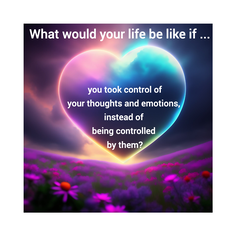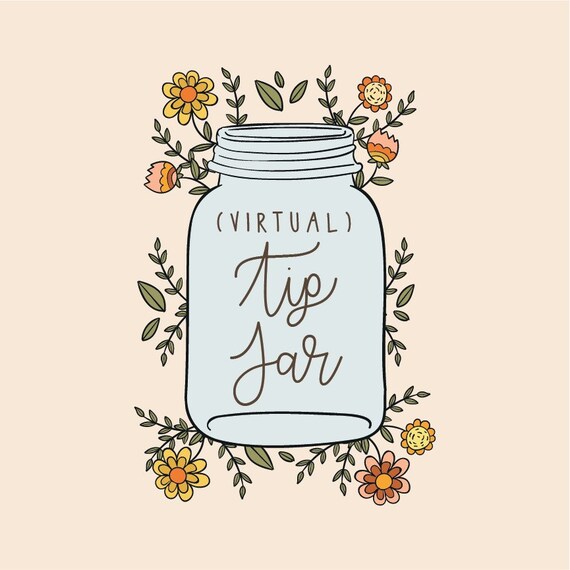
What Would Your Life Be Like If You Took Control of Your Thoughts and Emotions, Instead of Being Controlled by Them?
Our thoughts and emotions have a powerful impact on our lives. They shape our perceptions, influence our behaviors, and impact our relationships and overall well-being. But what would your life be like if you took control of your thoughts and emotions, instead of being controlled by them? In this blog post, we'll explore the benefits of taking control of your thoughts and emotions, and provide practical tips for doing so.
Why Take Control of Your Thoughts and Emotions?
Taking control of your thoughts and emotions can have a lot of benefits. It can help you:
So how can you take control of your thoughts and emotions, and use them to improve your life?
A Word About Your Brain Neurochemistry
Keep in mind that we can change our brain neurochemistry. It takes practice, but we can literally do it instantly! Studies have proven this, and you can experience it for yourself right now by trying two things.
First, play music! Put on a song that is a high vibing tune for you. One that makes you want to get up and move. Notice the change in your body that is literally fueled by an instant change in your brain neurochemistry!
Second, smile! Whether or not you feel like you have anything to smile about, move your mouth into a smile position. Next, make the smile even bigger, engaging your whole face. Even smile with your eyes! You don't have to be happy to do this. Just putting your mouth and face in the position of a smile changes your brain neurochemistry instantly.
The key is to notice when we are in a neurochemical state of anxiety, which is fueled by adrenaline and the fight, flight or freeze response, and take action to shift that state to one that serves us better. Music and smiling are definite options.
Practical Tips for Taking Control of Your Thoughts and Emotions
Here are some practical tips for taking control of your thoughts and emotions:
1) Practice Mindfulness
One of the first steps in taking control of your thoughts and emotions and reducing the body's neurotransmitter adrenaline, which often increases with anxiety, is practicing mindfulness. This involves being present in the moment, focusing on your breath, and observing your thoughts and emotions without judgment. By practicing mindfulness, you can become more aware of your internal experiences and learn to respond to them in a more intentional and constructive way. Here are two breathing tools that might be helpful while developing your mindfulness practice:
Another way to take control of your thoughts and emotions is to challenge your thoughts. This involves questioning negative or unhelpful thoughts and replacing them with more positive and constructive ones. For example, if you find yourself thinking "I can't do this," challenge that thought by asking yourself, "Is that really true? What evidence do I have to support that belief?" By challenging your thoughts, you can learn to think more critically and objectively, and reduce the impact of negative or unhelpful thinking patterns.
3) Practice Emotional Regulation
Emotional regulation involves recognizing and managing your emotions in a constructive way. This can involve strategies like deep breathing, visualization, or taking a break when you feel overwhelmed. By practicing emotional regulation, you can learn to respond to your emotions in a more intentional and constructive way, rather than being overwhelmed or controlled by them. Another highly effective strategy that helps with emotional regulation is called Aroma Freedom Techniques which is a science based set of tools using essential oils that help ease anxiety, . For more information about Aroma Reset, Aroma Freedom and related tools, click here to connect with a certified AFT practitioner to schedule a session.
4) Avoid Comparing Yourself to Others
Keep in mind that comparison is the thief of joy. Comparing yourself to others is not helpful unless you use it to inspire you. If you focus on failure, such as "I'll never be ..." and not being "as good as" someone else, anxiety will actually worsen. Repetitive thoughts only reinforce the anxiety. However, if you reframe the comparison and self talk to reinforce that you can "be" or "get better at" whatever you choose to be or get better at, it changes everything. If you focus on one small action that you can take towards whatever it is you choose to be or get better at, even better. And if you take that one small action and celebrate that as a victory, anxiety lessens as the neurochemicals in the brain shift.
5) Seek Out Support
Having a support system can be a powerful way to take control of your thoughts and emotions. Seek out friends, family, or a therapist who can offer encouragement, guidance, and feedback. Build relationships with people who share your values and goals, and who can help you stay focused and motivated, even when you experience setbacks.
6) Engage in Self-Care
It's important to engage in self-care when taking control of your thoughts and emotions. This can involve activities like exercise, meditation, or spending time in nature. By taking care of your physical and emotional needs, you can enhance your overall well-being and resilience, and feel more in control of your thoughts and emotions.
So what does it look like to take control of your thoughts and emotions, and use them to improve your life, in real life? Here are a few examples:
Taking control of your thoughts and emotions can be a powerful way to improve your life, reduce stress and anxiety, and enhance your relationships and overall well-being. By practicing mindfulness, challenging negative thoughts, regulating your emotions, seeking out support, and engaging in self-care, you can learn to respond to your internal experiences in a more intentional and constructive way.
Remember, you have thoughts and emotions, however you are not your thoughts or emotions. You have the power to manage them. By allowing your emotions to emerge and putting some space and breath between you and your emotions, you will become a curious observer. From this detached place, you are able to notice what might have triggered the emotion. By paying attention to the cause and effect, you can use intentional practices to manage them, thus creating a more fulfilling and meaningful life. Also, with this awareness, you will be able to make choices that decrease the triggers or shift your response to the triggers that fuel anxiety.
What will you do today to start taking control of your thoughts and emotions?
Our thoughts and emotions have a powerful impact on our lives. They shape our perceptions, influence our behaviors, and impact our relationships and overall well-being. But what would your life be like if you took control of your thoughts and emotions, instead of being controlled by them? In this blog post, we'll explore the benefits of taking control of your thoughts and emotions, and provide practical tips for doing so.
Why Take Control of Your Thoughts and Emotions?
Taking control of your thoughts and emotions can have a lot of benefits. It can help you:
- Reduce stress
- Manage anxiety
- Improve your relationships with others
- Increase your self-confidence
- Expand self-awareness
- Enhance your problem-solving skills
- Foster greater resilience and adaptability
So how can you take control of your thoughts and emotions, and use them to improve your life?
A Word About Your Brain Neurochemistry
Keep in mind that we can change our brain neurochemistry. It takes practice, but we can literally do it instantly! Studies have proven this, and you can experience it for yourself right now by trying two things.
First, play music! Put on a song that is a high vibing tune for you. One that makes you want to get up and move. Notice the change in your body that is literally fueled by an instant change in your brain neurochemistry!
Second, smile! Whether or not you feel like you have anything to smile about, move your mouth into a smile position. Next, make the smile even bigger, engaging your whole face. Even smile with your eyes! You don't have to be happy to do this. Just putting your mouth and face in the position of a smile changes your brain neurochemistry instantly.
The key is to notice when we are in a neurochemical state of anxiety, which is fueled by adrenaline and the fight, flight or freeze response, and take action to shift that state to one that serves us better. Music and smiling are definite options.
Practical Tips for Taking Control of Your Thoughts and Emotions
Here are some practical tips for taking control of your thoughts and emotions:
1) Practice Mindfulness
One of the first steps in taking control of your thoughts and emotions and reducing the body's neurotransmitter adrenaline, which often increases with anxiety, is practicing mindfulness. This involves being present in the moment, focusing on your breath, and observing your thoughts and emotions without judgment. By practicing mindfulness, you can become more aware of your internal experiences and learn to respond to them in a more intentional and constructive way. Here are two breathing tools that might be helpful while developing your mindfulness practice:
- Box breathing is a simple tool that will help you stay focused on your breath.
- Quick Coherence Heart Breathing
Another way to take control of your thoughts and emotions is to challenge your thoughts. This involves questioning negative or unhelpful thoughts and replacing them with more positive and constructive ones. For example, if you find yourself thinking "I can't do this," challenge that thought by asking yourself, "Is that really true? What evidence do I have to support that belief?" By challenging your thoughts, you can learn to think more critically and objectively, and reduce the impact of negative or unhelpful thinking patterns.
3) Practice Emotional Regulation
Emotional regulation involves recognizing and managing your emotions in a constructive way. This can involve strategies like deep breathing, visualization, or taking a break when you feel overwhelmed. By practicing emotional regulation, you can learn to respond to your emotions in a more intentional and constructive way, rather than being overwhelmed or controlled by them. Another highly effective strategy that helps with emotional regulation is called Aroma Freedom Techniques which is a science based set of tools using essential oils that help ease anxiety, . For more information about Aroma Reset, Aroma Freedom and related tools, click here to connect with a certified AFT practitioner to schedule a session.
4) Avoid Comparing Yourself to Others
Keep in mind that comparison is the thief of joy. Comparing yourself to others is not helpful unless you use it to inspire you. If you focus on failure, such as "I'll never be ..." and not being "as good as" someone else, anxiety will actually worsen. Repetitive thoughts only reinforce the anxiety. However, if you reframe the comparison and self talk to reinforce that you can "be" or "get better at" whatever you choose to be or get better at, it changes everything. If you focus on one small action that you can take towards whatever it is you choose to be or get better at, even better. And if you take that one small action and celebrate that as a victory, anxiety lessens as the neurochemicals in the brain shift.
5) Seek Out Support
Having a support system can be a powerful way to take control of your thoughts and emotions. Seek out friends, family, or a therapist who can offer encouragement, guidance, and feedback. Build relationships with people who share your values and goals, and who can help you stay focused and motivated, even when you experience setbacks.
6) Engage in Self-Care
It's important to engage in self-care when taking control of your thoughts and emotions. This can involve activities like exercise, meditation, or spending time in nature. By taking care of your physical and emotional needs, you can enhance your overall well-being and resilience, and feel more in control of your thoughts and emotions.
So what does it look like to take control of your thoughts and emotions, and use them to improve your life, in real life? Here are a few examples:
- A person who's always struggled with anxiety and self-doubt decides to seek out therapy, to better understand their thoughts and emotions. They learn to challenge negative thinking patterns, practice mindfulness and emotional regulation, and seek out support from their therapist and support system.
- A person who's always had difficulty in social situations decides to take a public speaking class, to improve their confidence and communication skills. They learn to challenge their negative thoughts about themselves and their abilities, practice visualization and deep breathing to manage their anxiety, and seek feedback and support from their classmates and instructor.
- A person who's always struggled with anger and impulsivity decides to start a meditation practice, to help them regulate their emotions and respond more calmly and constructively in difficult situations. They learn to observe their thoughts and emotions without judgment, practice deep breathing and visualization, and seek out support from a meditation community and teacher.
Taking control of your thoughts and emotions can be a powerful way to improve your life, reduce stress and anxiety, and enhance your relationships and overall well-being. By practicing mindfulness, challenging negative thoughts, regulating your emotions, seeking out support, and engaging in self-care, you can learn to respond to your internal experiences in a more intentional and constructive way.
Remember, you have thoughts and emotions, however you are not your thoughts or emotions. You have the power to manage them. By allowing your emotions to emerge and putting some space and breath between you and your emotions, you will become a curious observer. From this detached place, you are able to notice what might have triggered the emotion. By paying attention to the cause and effect, you can use intentional practices to manage them, thus creating a more fulfilling and meaningful life. Also, with this awareness, you will be able to make choices that decrease the triggers or shift your response to the triggers that fuel anxiety.
What will you do today to start taking control of your thoughts and emotions?


